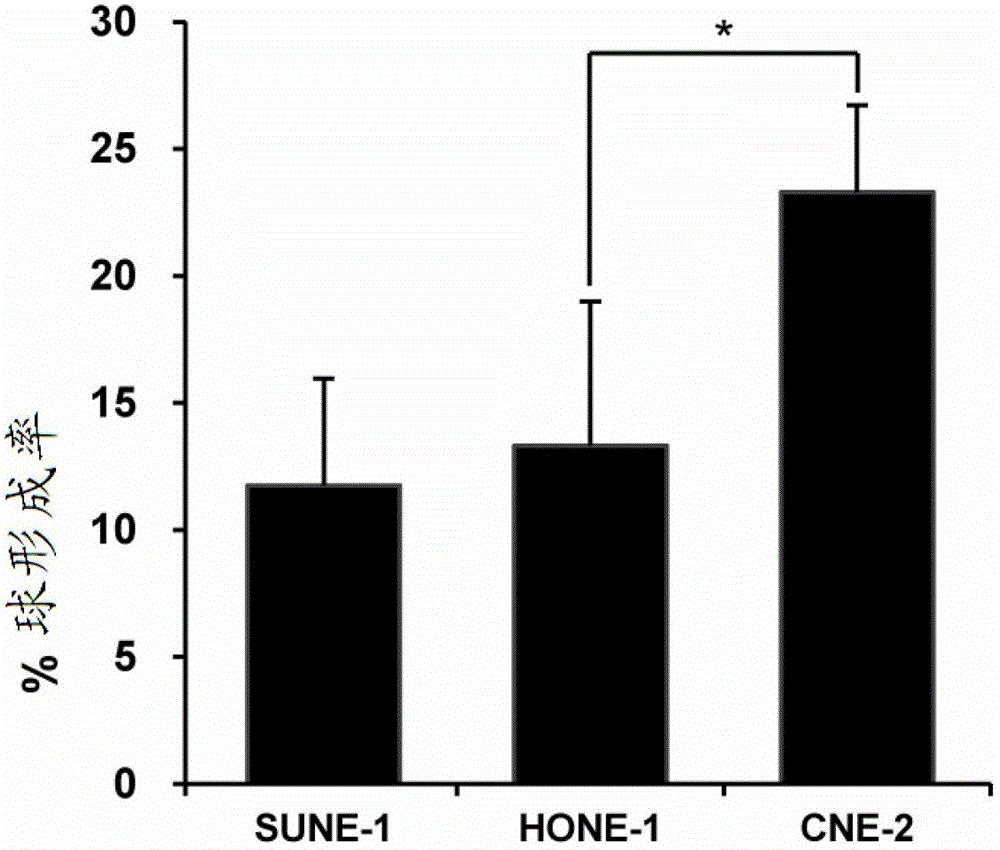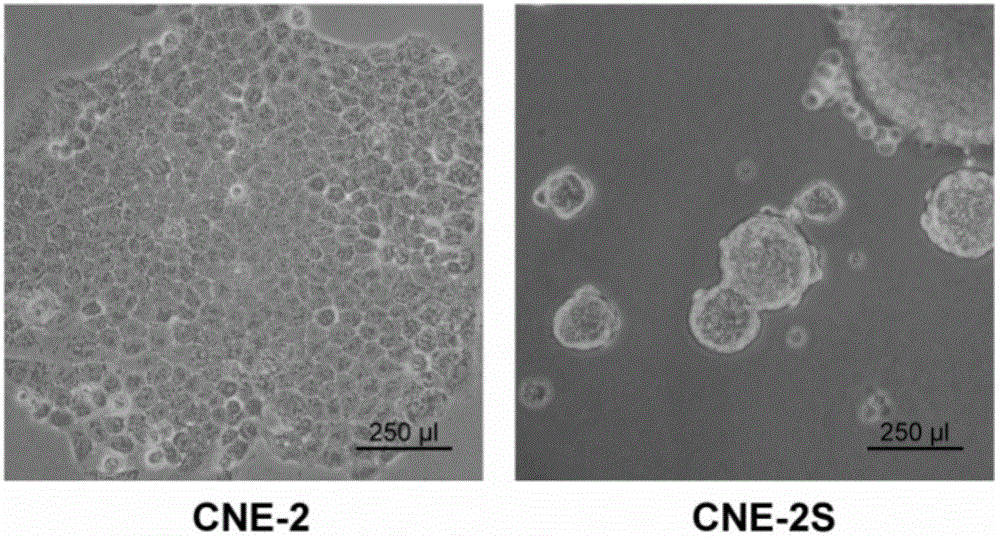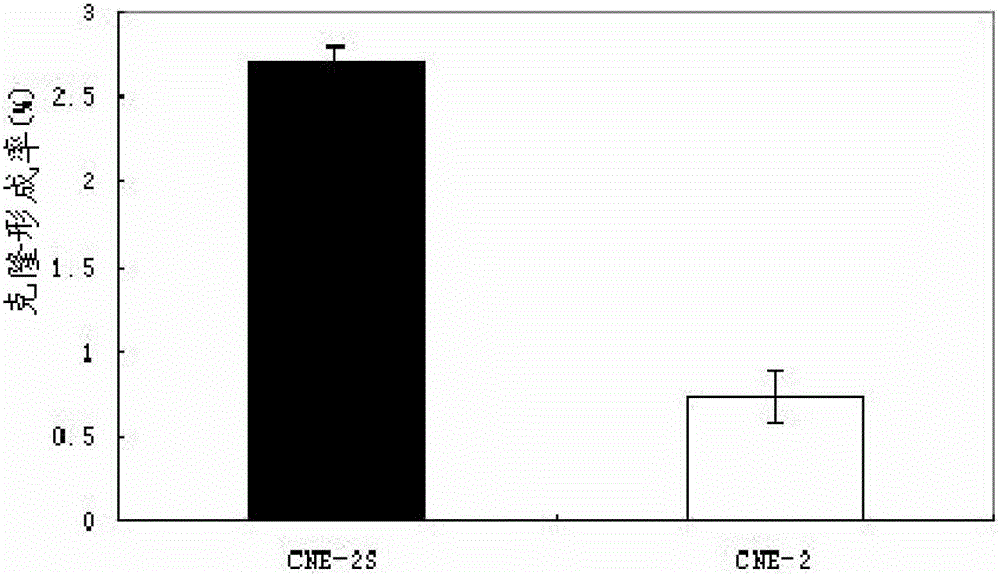Method for establishing human nasopharyngeal carcinoma tumor stem cell line
A tumor stem cell line, human nasopharyngeal carcinoma technology, applied in the biological and medical fields, can solve the problem of high incidence of nasopharyngeal carcinoma, and achieve the effects of simple operation, strong clone formation ability, and strong drug tolerance
- Summary
- Abstract
- Description
- Claims
- Application Information
AI Technical Summary
Problems solved by technology
Method used
Image
Examples
Embodiment 1
[0035] Example 1 Obtaining nasopharyngeal carcinoma sphere-forming cells
[0036] 1. Place nasopharyngeal carcinoma cells CNE-2, SUNE-1, and HONE-1 in DMEM / F12 (Gibco) medium containing 10% FBS (fetal bovine serum, Gibco) plus double antibodies at 37°C, 5% CO 2 Culture in the incubator;
[0037] 2. Select nasopharyngeal carcinoma cells CNE-2, SUNE-1, and HONE-1 in the logarithmic growth phase, digest them with trypsin at a mass volume percentage concentration of 0.25% to form a single-cell suspension, and add an appropriate amount of serum-containing medium to terminate Trypsinize, centrifuge at 1000rpm for 5min, discard the supernatant, add 1ml of serum-free stem cell medium containing epidermal growth factor EGF and basic fibroblast growth factor bFGF, and mix well. The medium is DMEM / F12, where The final concentration of EGF and bFGF is 20ng / ml;
[0038] 3. Cell counting: take 20ul and 20ul trypan blue to mix, take a cell counting plate and flush the pool, and count t...
Embodiment 3
[0052] Example 3 Drug resistance of nasopharyngeal carcinoma sphere-forming cells to the antineoplastic drug gemcitabine
[0053] 1. Prepare a 100 μmol / mL gemcitabine solution:
[0054] The molecular weight of gemcitabine is 299.66, that is, 29.966 mg / mL = 0.1mol / L, so weigh 0.2997g of gemcitabine and dissolve it in 10ml of DMEM / F12 medium, filter and sterilize, and store at 4°C for later use;
[0055] 2. Collect nasopharyngeal carcinoma sphere-forming cells CNE-2s, HONE-1s, and SUNE-1s in the logarithmic growth phase, and nasopharyngeal carcinoma cells CNE-2, HONE-1, and SUNE-1 used as reference, and digest them as Single cell suspension, count the cells, the counting steps are the same as step 3 in Example 1, adjust the cell concentration to 3 × 10 4 / mL;
[0056] 3. MTT detects the sensitivity of two types of cells to gemcitabine:
[0057] (1) Take nasopharyngeal carcinoma sphere-forming cells CNE-2s, HONE-1s and SUNE-1s in the logarithmic growth phase, and nasopharyn...
Embodiment 4
[0060] Example 4 RT-PCR method to detect the expression of stemness factor
[0061] 1. Design primers according to Table 1
[0062] Table 1
[0063]
[0064] 2. Total RNA extraction (TRIZOL, Invitrogen)
[0065] (1) Treatment of adherent cells CNE-2, HONE-1 and SUNE-1: Rinse the treated cells once with ice-cold PBS, directly add Trizol for lysis, the volume of Trizol is 10cm 2 / mL ratio added;
[0066] Treatment of suspension culture cells CNE-2s, HONE-1s and SUNE-1s: collect the cell spheroid suspension, centrifuge to remove the cell culture medium, then wash once with ice-cold PBS, and directly add Trizol to lyse;
[0067] (2) After adding Trizol, place at room temperature for 5 minutes to fully lyse;
[0068] (3) Centrifuge at 12000rpm at 4°C for 15 minutes, and discard the precipitate. This step is used to remove some insoluble substances such as cell outer membrane, high molecular weight DNA, polysaccharides, etc.;
[0069] (4) Add chloroform to 200μl chloroform...
PUM
 Login to View More
Login to View More Abstract
Description
Claims
Application Information
 Login to View More
Login to View More - R&D
- Intellectual Property
- Life Sciences
- Materials
- Tech Scout
- Unparalleled Data Quality
- Higher Quality Content
- 60% Fewer Hallucinations
Browse by: Latest US Patents, China's latest patents, Technical Efficacy Thesaurus, Application Domain, Technology Topic, Popular Technical Reports.
© 2025 PatSnap. All rights reserved.Legal|Privacy policy|Modern Slavery Act Transparency Statement|Sitemap|About US| Contact US: help@patsnap.com



